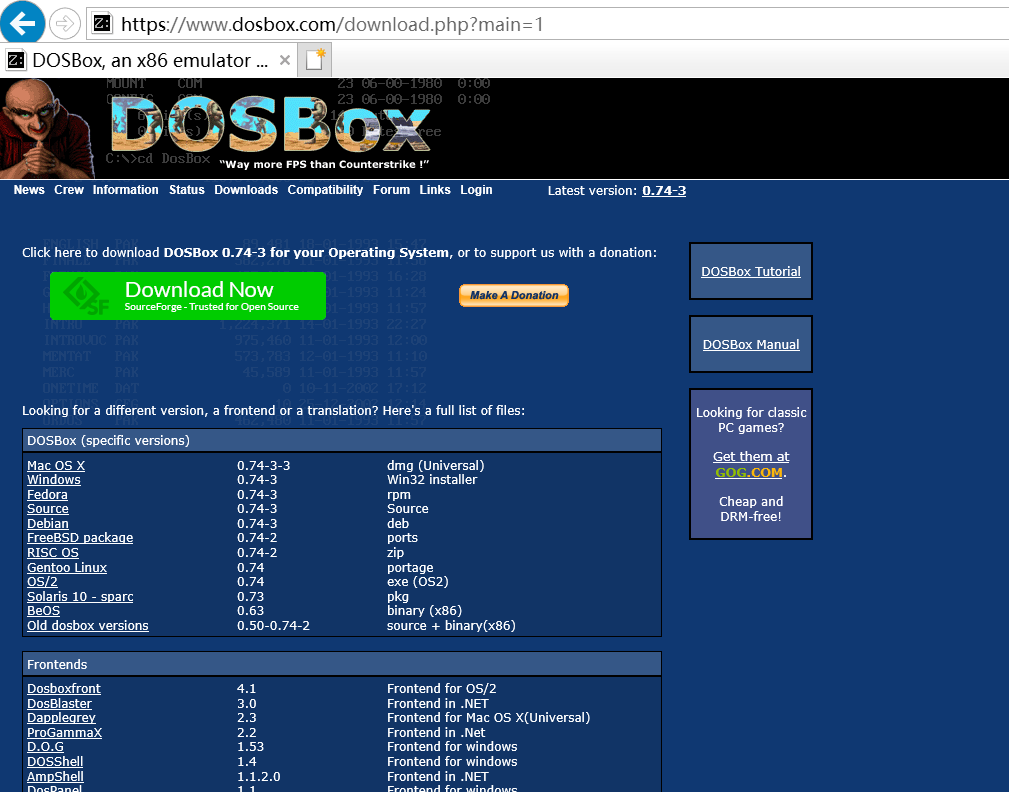
- Debug exe for dosbox .exe#
- Debug exe for dosbox install#
- Debug exe for dosbox for android#
- Debug exe for dosbox android#
- Debug exe for dosbox code#
The process for iOS is a bit trickier since Apple doesn't want you using programs like this.
Debug exe for dosbox android#
There are MANY versions available on the Android app store and each will work slightly differently, choose one that looks promising and try it out.
Debug exe for dosbox for android#
DOSBox on Android & iOS devices: DOSBox is also available for Android and iOS for mobile devices.
Debug exe for dosbox install#
Simply click Next, then Next again (change the installation location if you want), then Install to complete the process. Note that this guide focuses on Windows, but the process is similar on Mac, Linux, and other computer-based operating systems.
Run the installation program you will see a screen like this: (Windows, OSX, Linux the project has not been updated since 2015.) (Windows, Linux)ĭOSBox SVN Daum: Features include save states, graphical shaders, vertical sync, CPU flags optimization, additional DOS commands (PROMPT VOL, LABEL, MOUSE, etc) and more. You can dump the entire 1M address space by setting BX:CX to 10:0000 in step (6), and specifying an address of 0:0 in step (7).There are also some alternative versions of DOSBox available, based on the official source but improved with specific features:ĭOSBox ECE (Enhanced Community Edition): Features include 3Dfx Vooodoo card emulation, enhanced pixel-perfect scaling (4x, 5x, 6x), improved sound emulation, and more.

Here’s a list of the commands issued to DEBUG during this process: g 2000:1a18 2000:1a8c Finally, we restore the AX, BX, and CX registers, and let the program run to completion with the “ g” command. Next, following the procedure above, we name the dump file, set BX:CX to 0001:0000 (to dump an entire 64K segment) and issue the “ w DS:0” command to dump the data segment. Once we’re at our breakpoint, we need to note the values of AX, BX, and CX so that we can restore them later. This is fine for our purposes, however, as memory has certainly been initialized by the time the program gets around to quitting. When we run neuro.exe through the debugger, we find that neither breakpoint is hit until we exit the program, and the video mode is restored to 80×25 text. (Those are the addresses on my machine, at any rate: Yours may vary.) Using a technique discussed previously, we know that these opcodes will be found at memory addresses 2000:1a:1a8c. If we search the executable for INT 10h opcodes (two adjacent bytes equal to 0xcd 0x10) we find two, at file offsets 0xde68 and 0xdedc. after the program has had a chance to store data to memory). In order to take a meaningful memory dump, we need to find a good place to break program execution (i.e. For this example, I’ll be working with the PC version of the game, which includes a NEURO.EXE file with a md5 hash of: ExampleĬonsider the game “Neuromancer”, from 1989. Breakpoints set on INT 10h opcodes will tend to be hit at interesting points in the code. Until disassembly and analysis reveals the location of significant function calls in the program, interrupts are your best bet for finding interesting inflection points in the code.įor instance, the INT 10h interrupt is used for a large number of important (but relatively rare) video operations: setting the video mode, manipulating the palette, etc. In general, you want to stop somewhere “interesting” – a point at which memory has been populated with meaningful data. Picking a breakpoint at which to stop a new, unfamiliar program is not trivial. Restore the original values of AX, BX and CX.Dump memory, specifying the starting address, e.g.(Note that this is *not* a SEG:OFF value, this is a 32-bit value spread across two registers.) Store the number of bytes to dump in BX:CX.(Note that DEBUG won’t write files with a. Run to the breakpoint you’ve selected, e.g.
Debug exe for dosbox .exe#
exe from which you wish to dump memory as an argument, e.g.

The selection is left as an excercise for the reader, but I’ll assume you’ve got one picked out in SEG:OFF format.
Debug exe for dosbox code#
When analyzing a program, it’s sometimes helpful to deploy more powerful tools – such as custom code – to manipulate a memory image. The DOS DEBUG command provides only primitive facilities for the inspection of the contents of memory. Today, I present a brief guide to using that tool to take snapshots of running programs. As I’ve mentioned before, I like to use the DOS DEBUG command to investigate older 16-bit programs.


 0 kommentar(er)
0 kommentar(er)
